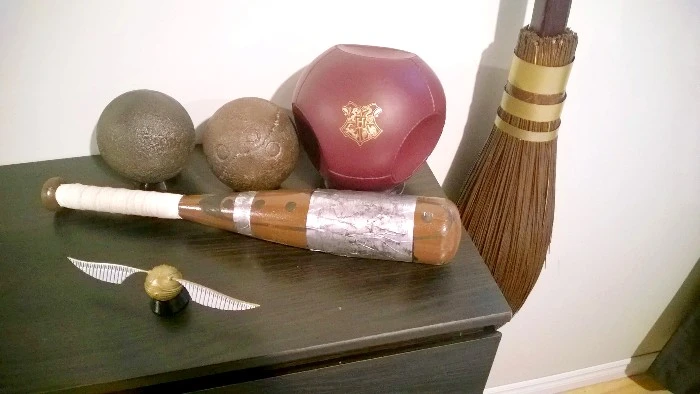Quidditch, the beloved fictional sport from J.K. Rowling’s Harry Potter series, has captivated the imaginations of millions of fans worldwide. With its unique blend of rugby, basketball, and aerial acrobatics, Quidditch is an exhilarating game that transports players and spectators into a magical realm. One of the most intriguing aspects of Quidditch is the presence of three distinct balls: the Quaffle, the Bludger, and the Golden Snitch. Among these balls, the largest and most prominent is the Quaffle. In this comprehensive guide, we will delve into the history, characteristics, and significance of the largest ball in Quidditch, shedding light on the enigma that has puzzled many Potterheads.
Unveiling the Quidditch Balls
Before we explore the intricacies of the Quaffle’s size, let’s take a moment to familiarize ourselves with the three primary balls used in the game of Quidditch:
- The Quaffle: This vibrant red, leather-bound ball takes center stage in every Quidditch match. It serves as the main scoring object and is handled by the Chasers, who aim to throw it through the opposing team’s hoops. The Quaffle’s size is comparable to that of a volleyball, making it the largest ball on the pitch.
- The Bludger: In contrast to the Quaffle, the Bludgers are menacing black iron balls. Enchanted with a malevolent spirit, they act as the game’s defensive element. Two Bludgers are in constant motion, targeting players and attempting to knock them off their brooms. These balls are smaller than the Quaffle, roughly the size of a soccer ball.
- The Golden Snitch: The smallest and most elusive of the three balls, the Golden Snitch plays a pivotal role in each Quidditch match. Resembling a tiny, winged golden sphere, the Snitch is released at the start of the game. Capturing the Snitch awards the capturing team 150 points and promptly ends the match. The Golden Snitch is significantly smaller than the Quaffle, approximately the size of a walnut.
The Quaffle: A Glimpse into its Magnitude
Now that we have acquainted ourselves with the Quidditch balls, let’s focus on the Quaffle, the largest among them. J.K. Rowling herself confirmed the Quaffle’s size in her book, “Quidditch Through the Ages,” describing it as “about the size of a football.” This comparison solidifies the Quaffle’s status as the largest ball in the game of Quidditch. Its generous dimensions contribute to the overall dynamics and gameplay experience, ensuring optimal visibility and facilitating swift maneuvers.
A Journey through Quidditch History
To truly appreciate the significance of the Quaffle’s size, let us take a step back into the history of Quidditch. In its early days, the Quaffle underwent several transformations before assuming its current form. Originally, the Quaffle was a twelve-inch diameter ball made of patched leather. Players could throw and catch it one-handedly, relying on its weight and shape to enhance their gameplay. However, adverse weather conditions, particularly heavy rain, posed a challenge. The muddy ground would camouflage the Quaffle, making it difficult for players to distinguish and retrieve it.
In response to this issue, Daisy Pennifold, a prominent figure in Quidditch history, proposed an enchantment to slow down the Quaffle’s descent. This modification allowed Chasers more time to seize the ball while airborne, eliminating the need for dangerous low-altitude maneuvers. The enchanted Quaffle, often referred to as the Pennifold Quaffle, revolutionized the game and ensured a safer and more engaging experience for players and spectators alike.
The Practical Implications of Size
The Quaffle’s size is not merely a trivial detail; it has significant practical implications for the game of Quidditch. Its larger dimensions make the Quaffle more visible and easier to track during gameplay, ensuring that players can quickly locate and execute swift maneuvers. Additionally, the increased size facilitates passing and catching, contributing to the fast-paced nature of the sport. Former Quidditch player and renowned commentator Oliver Wood emphasizes the crucial role of the Quaffle’s size, stating, “Its visibility on the pitch ensures that players can quickly locate it and execute swift maneuvers. If it were smaller, the gameplay would suffer, and the pace of the game would be significantly slower.”
Moreover, the size difference between the Quaffle and the other balls adds an element of challenge and excitement to Quidditch matches. Players must not only contend with the elusive Golden Snitch and the menacing Bludgers but also manage the larger and more predictable movements of the Quaffle. This asymmetry in ball sizes enhances the strategic depth of the game, requiring players to master various skills and adapt their gameplay accordingly.
The Misconception Surrounding the Golden Snitch
Despite the Quaffle’s undisputed status as the largest ball in Quidditch, a common misconception persists regarding the Golden Snitch’s size. This misconception likely stems from the Snitch’s symbolic significance and the attention it garners during gameplay. The capture of the Snitch marks a pivotal moment and often determines the outcome of a match. However, it is crucial to separate the Snitch’s importance as a game-ending element from its physical size. While the Snitch holds immense value, it remains significantly smaller than the Quaffle.
In Conclusion: The Quaffle Reigns Supreme
In the magical realm of Quidditch, the Quaffle stands as the largest and most prominent ball. Its size sets it apart from the other balls, enhancing gameplay dynamics and contributing to the overall excitement of Quidditch matches. Whether you’re a devoted Potterhead or a curious newcomer to the Wizarding World, you can now confidently engage in discussions about Quidditch, armed with the knowledge that the Quaffle is, indeed, the largest ball in this enchanting sport.
So, next time you find yourself immersed in a Quidditch match or engaging in a spirited debate with fellow fans, remember the significance of the Quaffle’s size. Embrace the magic of the Wizarding World and revel in the wonder of Quidditch, where the largest ball soars through the skies, captivating hearts and imaginations alike.
“Quidditch is a sport, not a game!”
– J.K. Rowling
